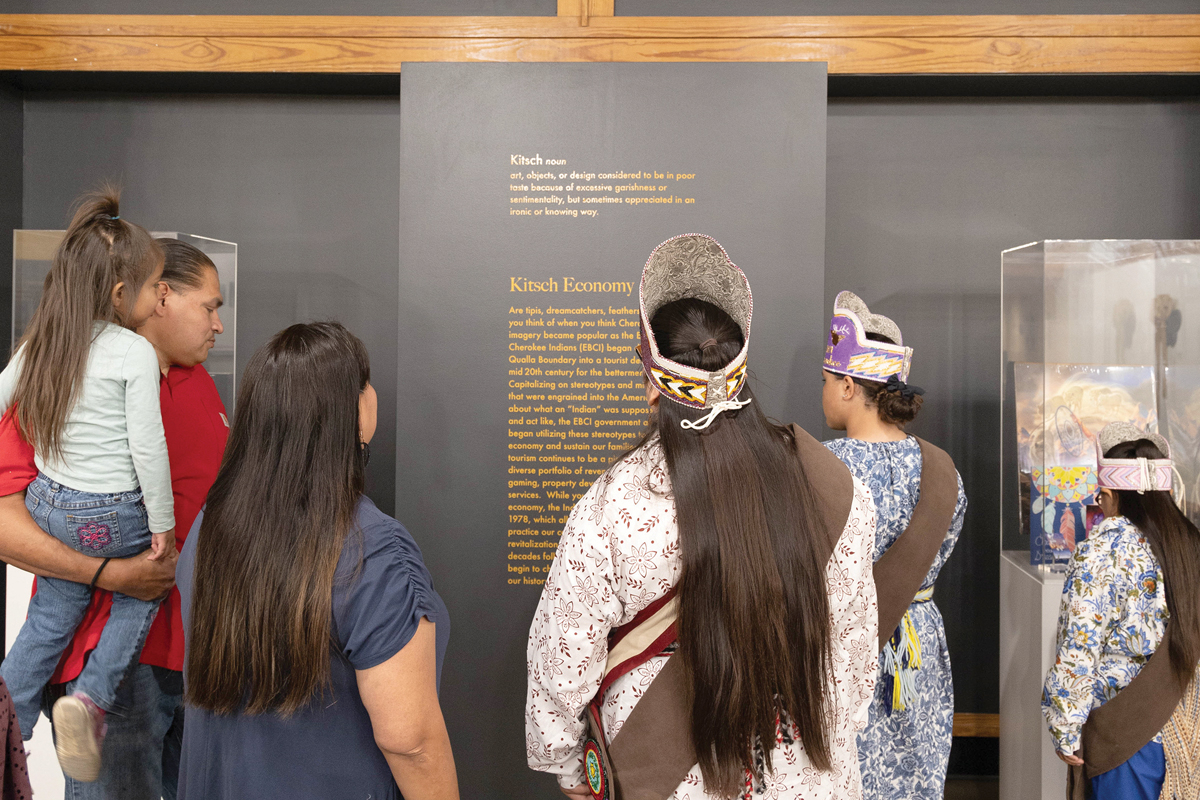New museum exhibition highlights EBCI sovereignty
 Guests lay eyes on the exhibition during an opening reception earlier this month. Photo courtesy of the Museum of the Cherokee People
Guests lay eyes on the exhibition during an opening reception earlier this month. Photo courtesy of the Museum of the Cherokee People
The Museum of the Cherokee People has opened a new attraction focused on the sovereignty of the Eastern Band.
“sov·er·eign·ty: Expressions in Sovereignty of the Eastern Band of Cherokee Indians” is an exhibition that illuminates the complexities of tribal sovereignty and the Eastern Band of Cherokee Indians’ continuing legacy of resilience. Featuring objects sourced from the Museum of the Cherokee People’s own collections, “sov·er·eign·ty” is designed to educate visitors about the Eastern Band of Cherokee Indians’ autonomy, its relationship with the federal government, and how the tribe has defined its own relationship with its land, people and culture.
The exhibition first defines sovereignty and explains how EBCI is a self-government autonomous nation that has its own laws and government. In 1830, following the Removal Act, which led to the forced displacement of several tribes across the nation, EBCI bought back its land and placed it in a federal trust. That land is called the Qualla Boundary. While other tribes live on federal reservations, that is not the case with EBCI, a sovereign nation that owns its own lands.
The explanation states that EBCI’s inherent sovereignty predates the United States.
“The Eastern Band of Cherokee Indians has defined over and again the relationship we have with our land, our people, and culture and how we have used our inherent sovereignty to advance our nation for the betterment of our tribe,” it reads. “It has been through adaptability and innovation that the EBCI has combated attempts to eradicate, remove, and assimilate our people and defined expressions of sovereignty throughout our history.”

Related Items
Guests to the exhibition will first encounter a basic explanation of EBCI sovereignty. Kyle Perrotti photo
Visitors come from all over to Cherokee and often come into the museum with preconceived notions based on American pop culture representations of different tribes — a representation that tends to paint all native peoples with the same brush. Visitors may expect tipis and head dresses, and when that expectation is turned upside-down, it provides the perfect opportunity to highlight the Eastern Band of Cherokee Indians’ sovereignty, which makes the culture, people and politics unique.
In addition to learning about the establishment and evolution of the EBCI’s tribal government, its enrollment criteria and ongoing relationship with the federal government, visitors can learn how Cherokee has cultivated its own tourist economy, something that has led some members to feel as though their culture may become compromised or even lost altogether.
The tourist-based economy grew substantially after the Great Smoky Mountains National Park was established in the 1930s. Dakota Brown, the museum’s director of education, said the key driver was the opening of one of the park’s entrances — where Oconaluftee visitor Center now sits — right on the edge of the Qualla Boundary.
“That brought people right through here all the time,” Brown said.
The influx of curious outsiders led to the development of Cherokee’s “kitsch economy,” through which some imagery that seems obviously — or even offensively — stereotypical was used in marketing EBCI’s burgeoning tourist economy.
“Prior to the development of the tourism economy, we were one of the poorest communities in the nation,” Brown said.
As part of a nationwide crackdown in an attempt to force assimilation, the federal government did all it could to dilute Cherokee culture, even going as far as outlawing ceremonial animal dances. However, as tourists became more enthralled with what seemed like an exotic culture, the ceremonies were allowed to be performed in front of visitors, which ironically helped keep those traditions alive. To illustrate this, the exhibition includes a ceremonial bear mask that was worn during such a dance, as well as an old photograph of an unidentified man wearing it while performing the ceremony.
“One of the positive things is that we kept that practice alive … at one point, this was mostly just seen as this very performative thing they did for tourists, but because they did that, we still know them,” Brown said.
“If your culture diminishes, it goes away, and eventually, your government and your sovereignty does, too,” she added.

The exhibit includes a ceremonial bear mask that was worn during such a dance, as well as an old photograph of an unidentified man wearing it while performing the ceremony. Kyle Perrotti photo
Now, in the wake of the 1978 Indian Religious Freedom Act, as new generations can freely perform ceremonies in ceremonial spaces instead of just in front of tourists, there has been a shift in Cherokee toward rediscovering how the ceremonies used to look and what they meant.
One section of the exhibition features items that visitors would likely consider exploitative at first glance, the very worst caricatures of Native Americans. However, they were created right there in the boundary by The Cherokee Manufacturing Company. At a time when so many trinkets were produced elsewhere and shipped to Cherokee’s gift shops, the tribe decided to take control of that economy. Several of the items produced are now on display, including a pendant with a stereotypical image of a Native American man in a feathered headdress.
But there were still little things the manufacturers were doing to insert bits of real Cherokee culture.
“Some of the Cherokee Manufacturing employees would write their names Cherokee syllabary in the catalog, and then there were even sections that talked about how we’re actually not a reservation and how we are on what’s called a boundary,” Brown said. “But this was about taking control of that market.”
While negative stereotypes of Native Americans still permeated society throughout the mid-20th century, Cherokee decided to use its annual fair as a means to show visitors its unique culture.
“The tribal fair became an important way to show our civility as a nation,” Brown said.
Ultimately, the prevailing theme of the exhibition is that for about the last 100 years, there has been a push and pull, a desire for EBCI to maintain its sovereignty, culture and sense of community while also wanting to build a thriving economy that could ensure members are taken care of. While Brown said she understands the criticism of the tourism economy from some community members that she’s heard over the years, she thinks it was a means to an end for her people. She relayed her own story to illustrate the nuance of her point. When she was younger, her mom and dad started a company and would buy some of the items from the Cherokee Manufacturing Company. Brown said she asked her father why they would buy items that would perpetuate a negative stereotype.

“My dad’s response to that is, ‘when we buy from the Cherokees, it supports our tribe and the families in our community that work there,’” Brown recalled. “So you could take it at face value and be like, ‘Oh, this is maybe wrong’ or that it’s perpetuating the wrong image, but it was valuable to this community in a time of great need.”
“Is it needed anymore? Probably not,” she added. “And is it something that we can move away from now? Yes. I think we’ve reached that place. As far as our economy goes, we’re stable enough that maybe we don’t have to do those things.”
Brown said that while the museum frequently gets visitors from all over who are interested in Cherokee history and culture, the museum’s mission has somewhat shifted back toward also serving the community.
“That’s something our leadership feels pretty strong about,” she said. “We want to be of service to our community, so with any decision we make, we are always asking ‘how does this create pride in our community while also educating visitors?’ I think we can always find a balance between the two.”
Brown called attention to the fact that while the exhibition was purposefully curated and features some unique items, it is relatively small. That’s because the museum’s main exhibition is closed to the public in preparation for a long renovation project.
“The sovereignty exhibit is not meant to be a replacement for our permanent exhibit,” Brown said. “We are going to be updating that at some point, and we are hoping to update the entire museum. We’re actively working toward that goal, so this is just a small, temporary exhibit that we can still invite people to and allow them to participate with our museum.”
“sov·er·eign·ty” is on view through Feb. 28, 2025, at the Museum of the Cherokee People’s public facility in the heart of Cherokee’s Cultural District. The Museum Store is open from 9 a.m. to 5 p.m. daily. Tickets can be purchased at motcp.org.









